2008 NISSAN TEANA engine
[x] Cancel search: enginePage 4399 of 5121
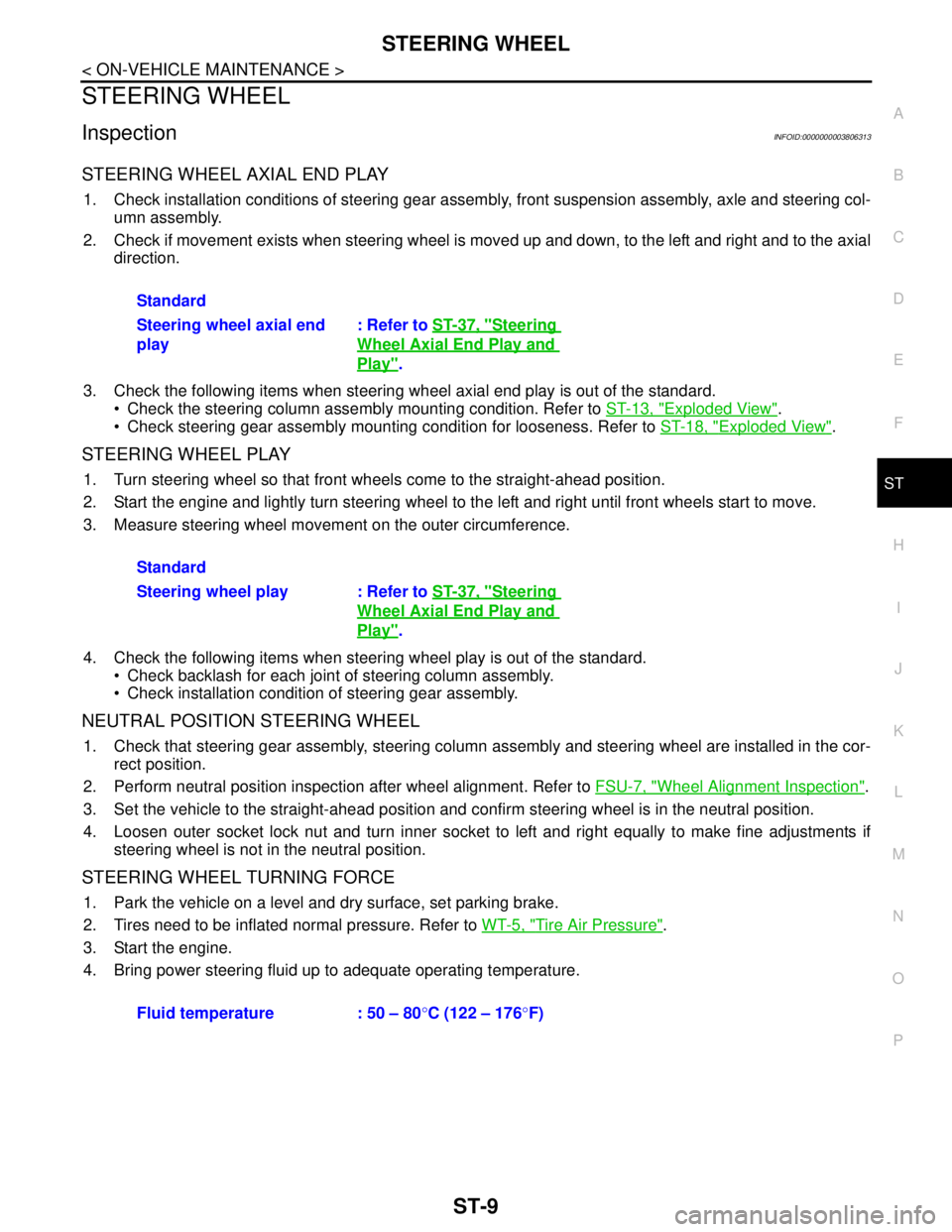
STEERING WHEEL
ST-9
< ON-VEHICLE MAINTENANCE >
C
D
E
F
H
I
J
K
L
MA
B
ST
N
O
P
STEERING WHEEL
InspectionINFOID:0000000003806313
STEERING WHEEL AXIAL END PLAY
1. Check installation conditions of steering gear assembly, front suspension assembly, axle and steering col-
umn assembly.
2. Check if movement exists when steering wheel is moved up and down, to the left and right and to the axial
direction.
3. Check the following items when steering wheel axial end play is out of the standard.
Check the steering column assembly mounting condition. Refer to ST-13, "
Exploded View".
Check steering gear assembly mounting condition for looseness. Refer to ST-18, "
Exploded View".
STEERING WHEEL PLAY
1. Turn steering wheel so that front wheels come to the straight-ahead position.
2. Start the engine and lightly turn steering wheel to the left and right until front wheels start to move.
3. Measure steering wheel movement on the outer circumference.
4. Check the following items when steering wheel play is out of the standard.
Check backlash for each joint of steering column assembly.
Check installation condition of steering gear assembly.
NEUTRAL POSITION STEERING WHEEL
1. Check that steering gear assembly, steering column assembly and steering wheel are installed in the cor-
rect position.
2. Perform neutral position inspection after wheel alignment. Refer to FSU-7, "
Wheel Alignment Inspection".
3. Set the vehicle to the straight-ahead position and confirm steering wheel is in the neutral position.
4. Loosen outer socket lock nut and turn inner socket to left and right equally to make fine adjustments if
steering wheel is not in the neutral position.
STEERING WHEEL TURNING FORCE
1. Park the vehicle on a level and dry surface, set parking brake.
2. Tires need to be inflated normal pressure. Refer to WT-5, "
Tire Air Pressure".
3. Start the engine.
4. Bring power steering fluid up to adequate operating temperature.Standard
Steering wheel axial end
play: Refer to ST-37, "
Steering
Wheel Axial End Play and
Play".
Standard
Steering wheel play : Refer to ST-37, "
Steering
Wheel Axial End Play and
Play".
Fluid temperature : 50 – 80°C (122 – 176°F)
Page 4400 of 5121
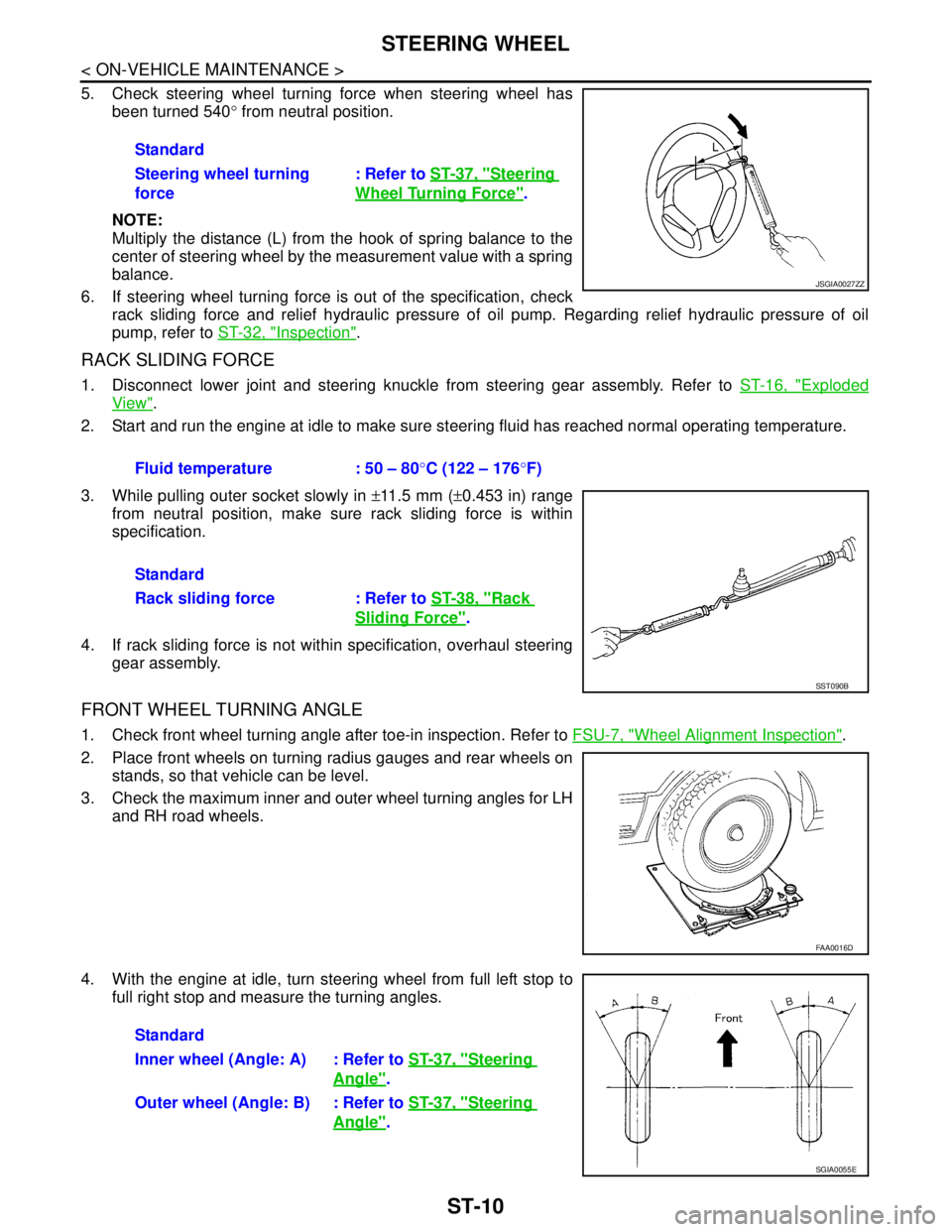
ST-10
< ON-VEHICLE MAINTENANCE >
STEERING WHEEL
5. Check steering wheel turning force when steering wheel has
been turned 540° from neutral position.
NOTE:
Multiply the distance (L) from the hook of spring balance to the
center of steering wheel by the measurement value with a spring
balance.
6. If steering wheel turning force is out of the specification, check
rack sliding force and relief hydraulic pressure of oil pump. Regarding relief hydraulic pressure of oil
pump, refer to ST-32, "
Inspection".
RACK SLIDING FORCE
1. Disconnect lower joint and steering knuckle from steering gear assembly. Refer to ST-16, "Exploded
View".
2. Start and run the engine at idle to make sure steering fluid has reached normal operating temperature.
3. While pulling outer socket slowly in ±11.5 mm (±0.453 in) range
from neutral position, make sure rack sliding force is within
specification.
4. If rack sliding force is not within specification, overhaul steering
gear assembly.
FRONT WHEEL TURNING ANGLE
1. Check front wheel turning angle after toe-in inspection. Refer to FSU-7, "Wheel Alignment Inspection".
2. Place front wheels on turning radius gauges and rear wheels on
stands, so that vehicle can be level.
3. Check the maximum inner and outer wheel turning angles for LH
and RH road wheels.
4. With the engine at idle, turn steering wheel from full left stop to
full right stop and measure the turning angles.Standard
Steering wheel turning
force: Refer to ST-37, "
Steering
Wheel Turning Force".
JSGIA0027ZZ
Fluid temperature : 50 – 80°C (122 – 176°F)
Standard
Rack sliding force : Refer to ST-38, "
Rack
Sliding Force".
SST090B
FAA0016D
Standard
Inner wheel (Angle: A) : Refer to ST-37, "
Steering
Angle".
Outer wheel (Angle: B) : Refer to ST-37, "
Steering
Angle".
SGIA0055E
Page 4409 of 5121
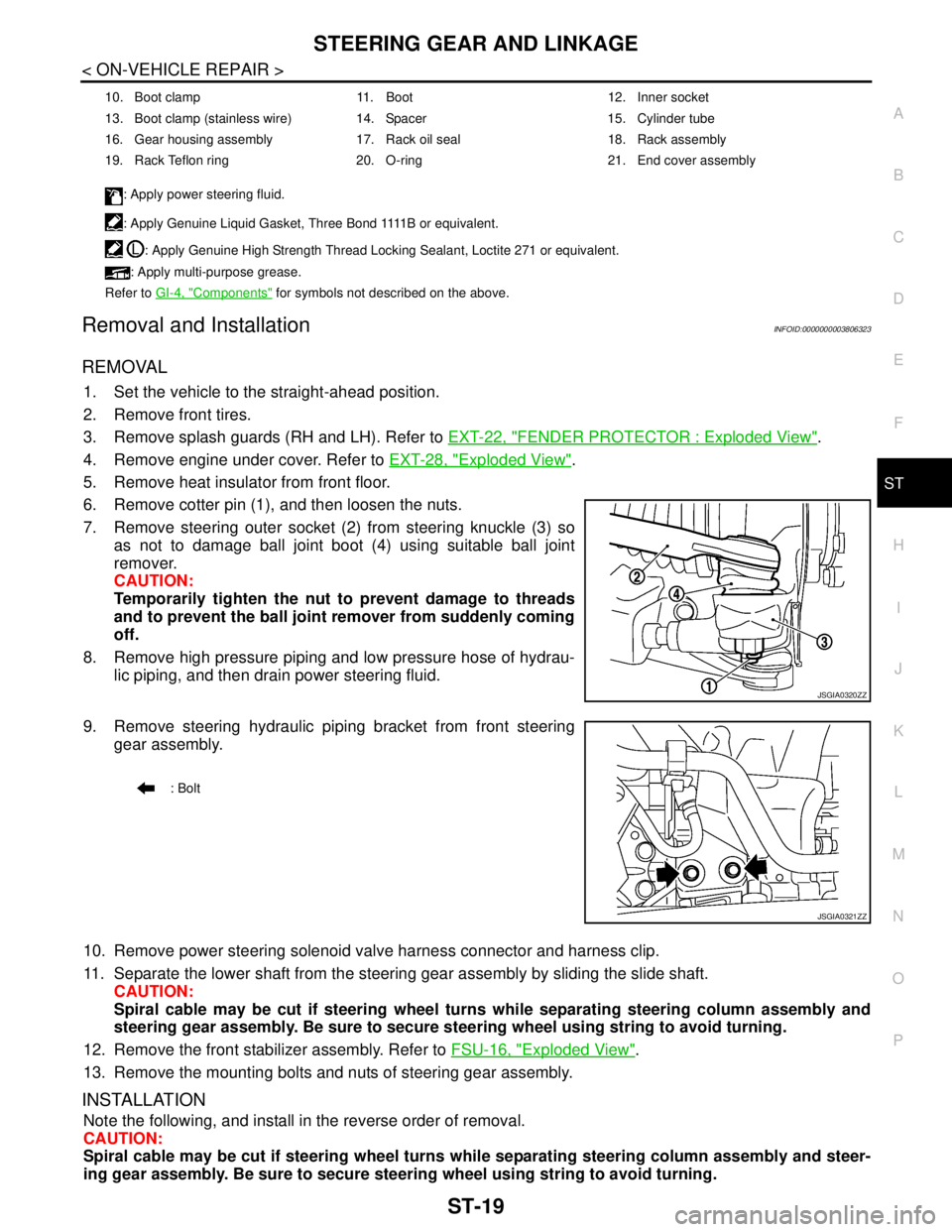
STEERING GEAR AND LINKAGE
ST-19
< ON-VEHICLE REPAIR >
C
D
E
F
H
I
J
K
L
MA
B
ST
N
O
P
Removal and InstallationINFOID:0000000003806323
REMOVAL
1. Set the vehicle to the straight-ahead position.
2. Remove front tires.
3. Remove splash guards (RH and LH). Refer to EXT-22, "
FENDER PROTECTOR : Exploded View".
4. Remove engine under cover. Refer to EXT-28, "
Exploded View".
5. Remove heat insulator from front floor.
6. Remove cotter pin (1), and then loosen the nuts.
7. Remove steering outer socket (2) from steering knuckle (3) so
as not to damage ball joint boot (4) using suitable ball joint
remover.
CAUTION:
Temporarily tighten the nut to prevent damage to threads
and to prevent the ball joint remover from suddenly coming
off.
8. Remove high pressure piping and low pressure hose of hydrau-
lic piping, and then drain power steering fluid.
9. Remove steering hydraulic piping bracket from front steering
gear assembly.
10. Remove power steering solenoid valve harness connector and harness clip.
11. Separate the lower shaft from the steering gear assembly by sliding the slide shaft.
CAUTION:
Spiral cable may be cut if steering wheel turns while separating steering column assembly and
steering gear assembly. Be sure to secure steering wheel using string to avoid turning.
12. Remove the front stabilizer assembly. Refer to FSU-16, "
Exploded View".
13. Remove the mounting bolts and nuts of steering gear assembly.
INSTALLATION
Note the following, and install in the reverse order of removal.
CAUTION:
Spiral cable may be cut if steering wheel turns while separating steering column assembly and steer-
ing gear assembly. Be sure to secure steering wheel using string to avoid turning.
10. Boot clamp 11. Boot 12. Inner socket
13. Boot clamp (stainless wire) 14. Spacer 15. Cylinder tube
16. Gear housing assembly 17. Rack oil seal 18. Rack assembly
19. Rack Teflon ring 20. O-ring 21. End cover assembly
: Apply power steering fluid.
: A p p l y G e n u i n e L i q u i d G a s k e t , T h r e e B o n d 1111 B o r e q u i v a l e n t .
: Apply Genuine High Strength Thread Locking Sealant, Loctite 271 or equivalent.
: Apply multi-purpose grease.
Refer to GI-4, "
Components" for symbols not described on the above.
JSGIA0320ZZ
: Bolt
JSGIA0321ZZ
Page 4422 of 5121
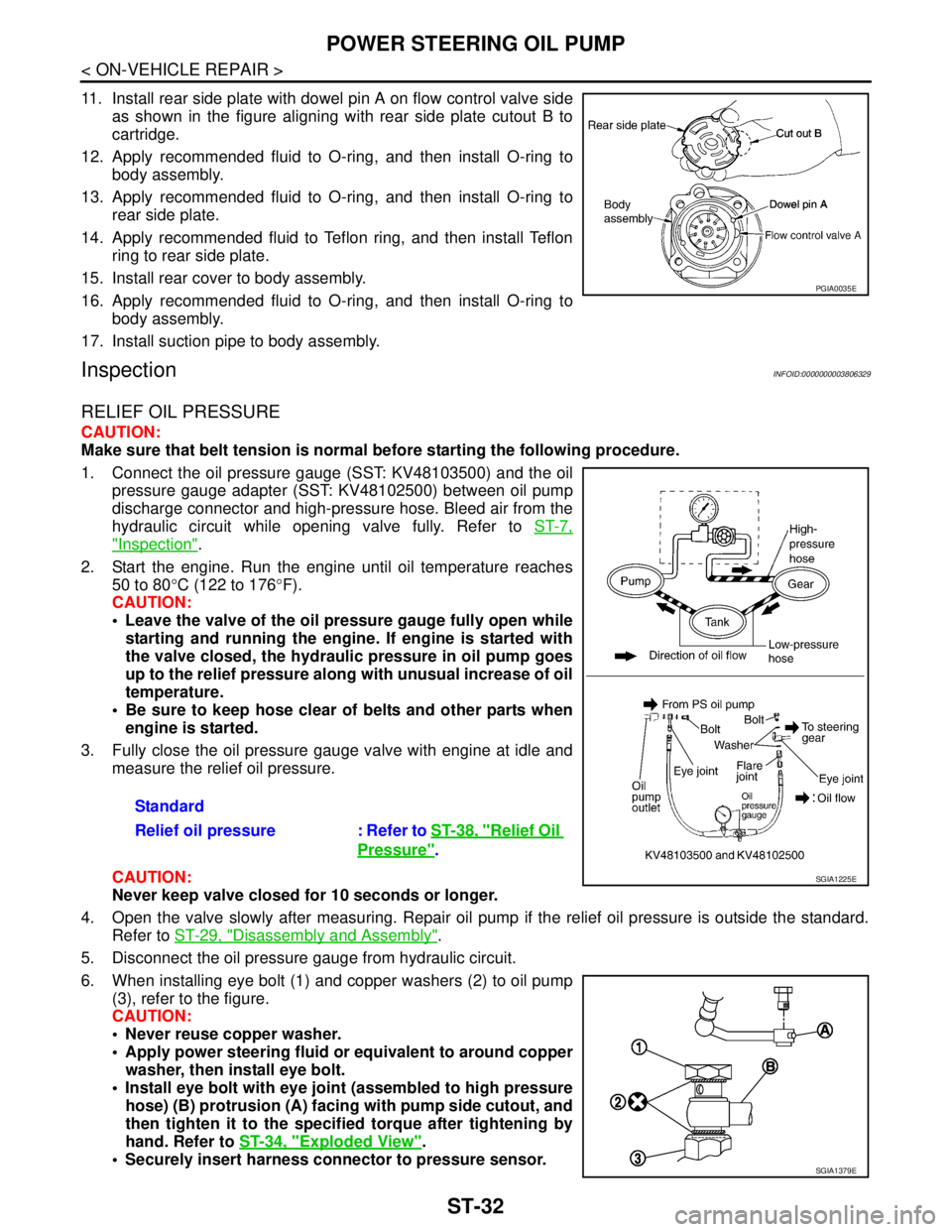
ST-32
< ON-VEHICLE REPAIR >
POWER STEERING OIL PUMP
11. Install rear side plate with dowel pin A on flow control valve side
as shown in the figure aligning with rear side plate cutout B to
cartridge.
12. Apply recommended fluid to O-ring, and then install O-ring to
body assembly.
13. Apply recommended fluid to O-ring, and then install O-ring to
rear side plate.
14. Apply recommended fluid to Teflon ring, and then install Teflon
ring to rear side plate.
15. Install rear cover to body assembly.
16. Apply recommended fluid to O-ring, and then install O-ring to
body assembly.
17. Install suction pipe to body assembly.
InspectionINFOID:0000000003806329
RELIEF OIL PRESSURE
CAUTION:
Make sure that belt tension is normal before starting the following procedure.
1. Connect the oil pressure gauge (SST: KV48103500) and the oil
pressure gauge adapter (SST: KV48102500) between oil pump
discharge connector and high-pressure hose. Bleed air from the
hydraulic circuit while opening valve fully. Refer to ST-7,
"Inspection".
2. Start the engine. Run the engine until oil temperature reaches
50 to 80°C (122 to 176°F).
CAUTION:
Leave the valve of the oil pressure gauge fully open while
starting and running the engine. If engine is started with
the valve closed, the hydraulic pressure in oil pump goes
up to the relief pressure along with unusual increase of oil
temperature.
Be sure to keep hose clear of belts and other parts when
engine is started.
3. Fully close the oil pressure gauge valve with engine at idle and
measure the relief oil pressure.
CAUTION:
Never keep valve closed for 10 seconds or longer.
4. Open the valve slowly after measuring. Repair oil pump if the relief oil pressure is outside the standard.
Refer to ST-29, "
Disassembly and Assembly".
5. Disconnect the oil pressure gauge from hydraulic circuit.
6. When installing eye bolt (1) and copper washers (2) to oil pump
(3), refer to the figure.
CAUTION:
Never reuse copper washer.
Apply power steering fluid or equivalent to around copper
washer, then install eye bolt.
Install eye bolt with eye joint (assembled to high pressure
hose) (B) protrusion (A) facing with pump side cutout, and
then tighten it to the specified torque after tightening by
hand. Refer to ST-34, "
Exploded View".
Securely insert harness connector to pressure sensor.
PGIA0035E
Standard
Relief oil pressure : Refer to ST-38, "
Relief Oil
Pressure".
SGIA1225E
SGIA1379E
Page 4429 of 5121

STC-1
STEERING
C
DE
F
H I
J
K L
M
SECTION STC
A
B
STC
N
O P
CONTENTS
STEERING CONTROL SYSTEM
BASIC INSPECTION ....... .............................2
DIAGNOSIS AND REPAIR WORK FLOW .... .....2
Work Flow ........................................................... ......2
FUNCTION DIAGNOSIS ...............................3
EPS SYSTEM ... .............................................. .....3
System Diagram .................................................. ......3
System Description ...................................................3
Component Parts Location ........................................5
Component Description .............................................5
COMPONENT DIAGNOSIS ..........................6
POWER SUPPLY AND GROUND CIRCUIT .. .....6
Description .......................................................... ......6
Diagnosis Procedure .................................................6
POWER STEERING SOLENOID VALVE ...........7
Description .......................................................... ......7
Diagnosis Procedure .................................................7
Component Inspection ..............................................8
ENGINE SPEED SIGNAL CIRCUIT ............... .....9
Description .......................................................... ......9
Diagnosis Procedure .................................................9
VEHICLE SPEED SIGNAL CIRCUIT .................11
Description .......................................................... ....11
Diagnosis Procedure ...............................................11
ECU DIAGNOSIS .........................................13
POWER STEERING CONTROL UNIT ..............13
Reference Value .................................................. ....13
Wiring Diagram - ELECTRONICALLY CON-
TROLLED POWER STEERING SYSTEM - ............
14
Fail-Safe .............................................................. ....15
SYMPTOM DIAGNOSIS ..............................17
UNBALANCE STEERING WHEEL TURNING
FORCE (TORQUE VARIATION) .......................
17
Description ........................................................... ....17
Diagnosis Procedure ...............................................17
PRECAUTION ..............................................18
PRECAUTIONS .................................................18
Precaution for Supplemental Restraint System
(SRS) "AIR BAG" and "SEAT BELT PRE-TEN-
SIONER" ............................................................. ....
18
Precaution Necessary for Steering Wheel Rota-
tion after Battery Disconnect ...................................
18
ON-VEHICLE REPAIR .................................19
POWER STEERING CONTROL UNIT ..............19
Exploded View ..................................................... ....19
Removal and Installation .........................................19
Page 4434 of 5121
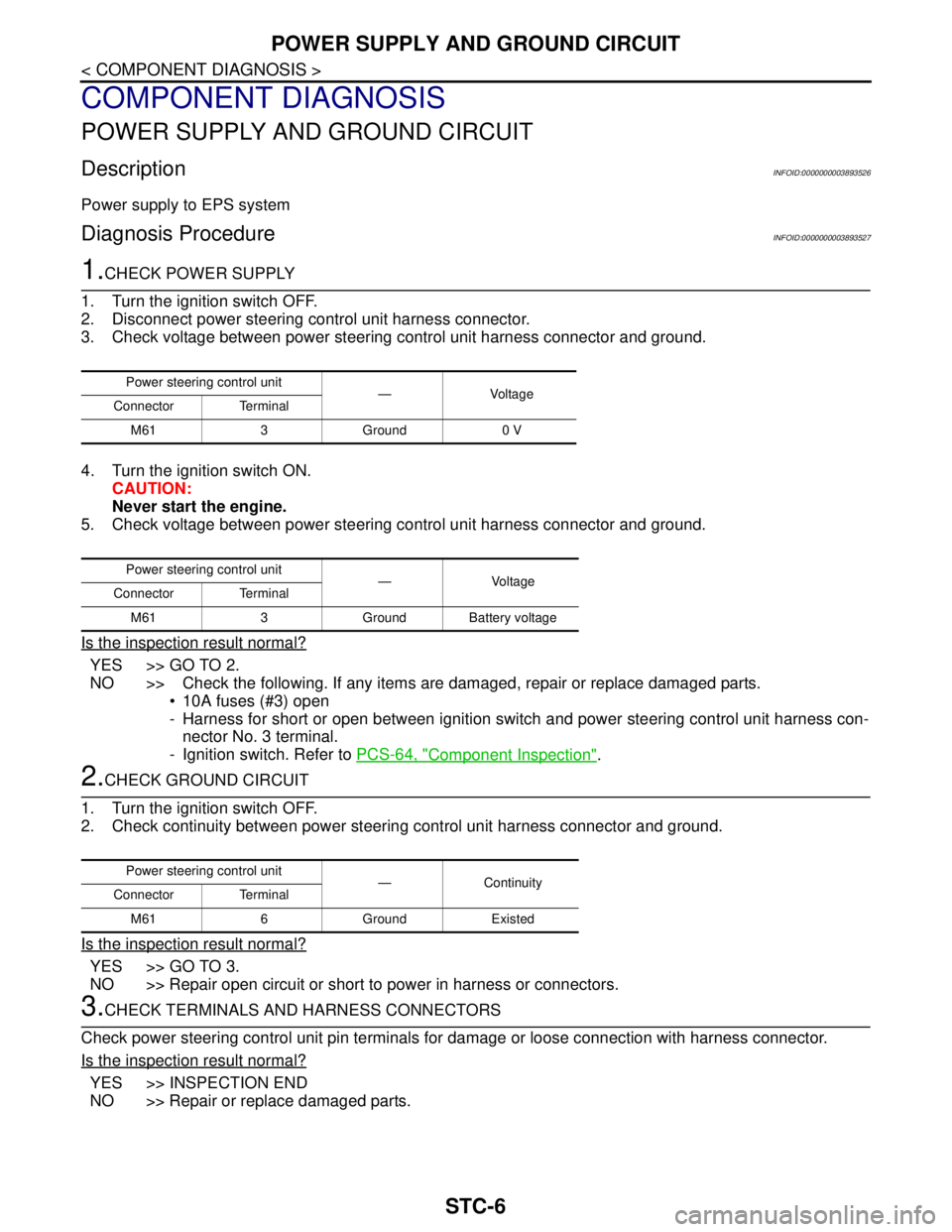
STC-6
< COMPONENT DIAGNOSIS >
POWER SUPPLY AND GROUND CIRCUIT
COMPONENT DIAGNOSIS
POWER SUPPLY AND GROUND CIRCUIT
DescriptionINFOID:0000000003893526
Power supply to EPS system
Diagnosis ProcedureINFOID:0000000003893527
1.CHECK POWER SUPPLY
1. Turn the ignition switch OFF.
2. Disconnect power steering control unit harness connector.
3. Check voltage between power steering control unit harness connector and ground.
4. Turn the ignition switch ON.
CAUTION:
Never start the engine.
5. Check voltage between power steering control unit harness connector and ground.
Is the inspection result normal?
YES >> GO TO 2.
NO >> Check the following. If any items are damaged, repair or replace damaged parts.
10A fuses (#3) open
- Harness for short or open between ignition switch and power steering control unit harness con-
nector No. 3 terminal.
- Ignition switch. Refer to PCS-64, "
Component Inspection".
2.CHECK GROUND CIRCUIT
1. Turn the ignition switch OFF.
2. Check continuity between power steering control unit harness connector and ground.
Is the inspection result normal?
YES >> GO TO 3.
NO >> Repair open circuit or short to power in harness or connectors.
3.CHECK TERMINALS AND HARNESS CONNECTORS
Check power steering control unit pin terminals for damage or loose connection with harness connector.
Is the inspection result normal?
YES >> INSPECTION END
NO >> Repair or replace damaged parts.
Power steering control unit
—Voltage
Connector Terminal
M61 3 Ground 0 V
Power steering control unit
— Voltage
Connector Terminal
M61 3 Ground Battery voltage
Power steering control unit
—Continuity
Connector Terminal
M61 6 Ground Existed
Page 4435 of 5121

POWER STEERING SOLENOID VALVE
STC-7
< COMPONENT DIAGNOSIS >
C
D
E
F
H
I
J
K
L
MA
B
STC
N
O
P
POWER STEERING SOLENOID VALVE
DescriptionINFOID:0000000003893528
Power steering solenoid valve controls the power steering oil pressure in the gear housing assembly.
Diagnosis ProcedureINFOID:0000000003893529
1.CHECK POWER STEERING SOLENOID VALVE SIGNAL
1. Turn the ignition switch OFF.
2. Check voltage between power steering control unit harness connector and ground.
Is the inspection result normal?
YES >> GO TO 2.
NO >> GO TO 4.
2.CHECK HARNESS BETWEEN POWER STEERING SOLENOID VALVE AND POWER STEERING CON-
TROL UNIT
1. Turn the ignition switch OFF.
2. Disconnect power steering solenoid valve harness connector.
3. Disconnect power steering control unit harness connector.
4. Check the continuity between power steering solenoid valve harness connector and the power steering
control unit harness connector.
5. Check continuity between power steering control unit harness connector and ground.
Is the inspection result normal?
YES >> GO TO 3.
NO >> Repair or replace damaged parts.
3.CHECK POWER STEERING SOLENOID VALVE
Check power steering solenoid valve. Refer to STC-8, "
Component Inspection".
Is the inspection result normal?
YES >> GO TO 4.
NO >> Replace gear-sub assembly. Refer to ST-18, "
Exploded View".
4.CHECK TERMINALS AND HARNESS CONNECTORS
Check power steering control unit pin terminals for damage or loose connection with harness connector.
Check power steering solenoid valve pin terminals for damage or loose connection with harness connector.
Is the inspection result normal?
Power steering control unit
— Condition Voltage (Approx.)
Connector Terminal
M61 1 GroundVehicle speed: 0 km/h (0 MPH)
(Engine is running)4.4 – 6.6 V
Vehicle speed: 100 km/h (62 MPH) 2.4 – 3.6 V
Power steering solenoid valve Power steering control unit
Continuity
Connector Terminal Connector Terminal
E52 1 M61 1 Existed
E52 2 M61 5 Existed
Power steering control unit
—Continuity
Connector Terminal
M61 1
Ground Not existed
M61 5
Page 4437 of 5121
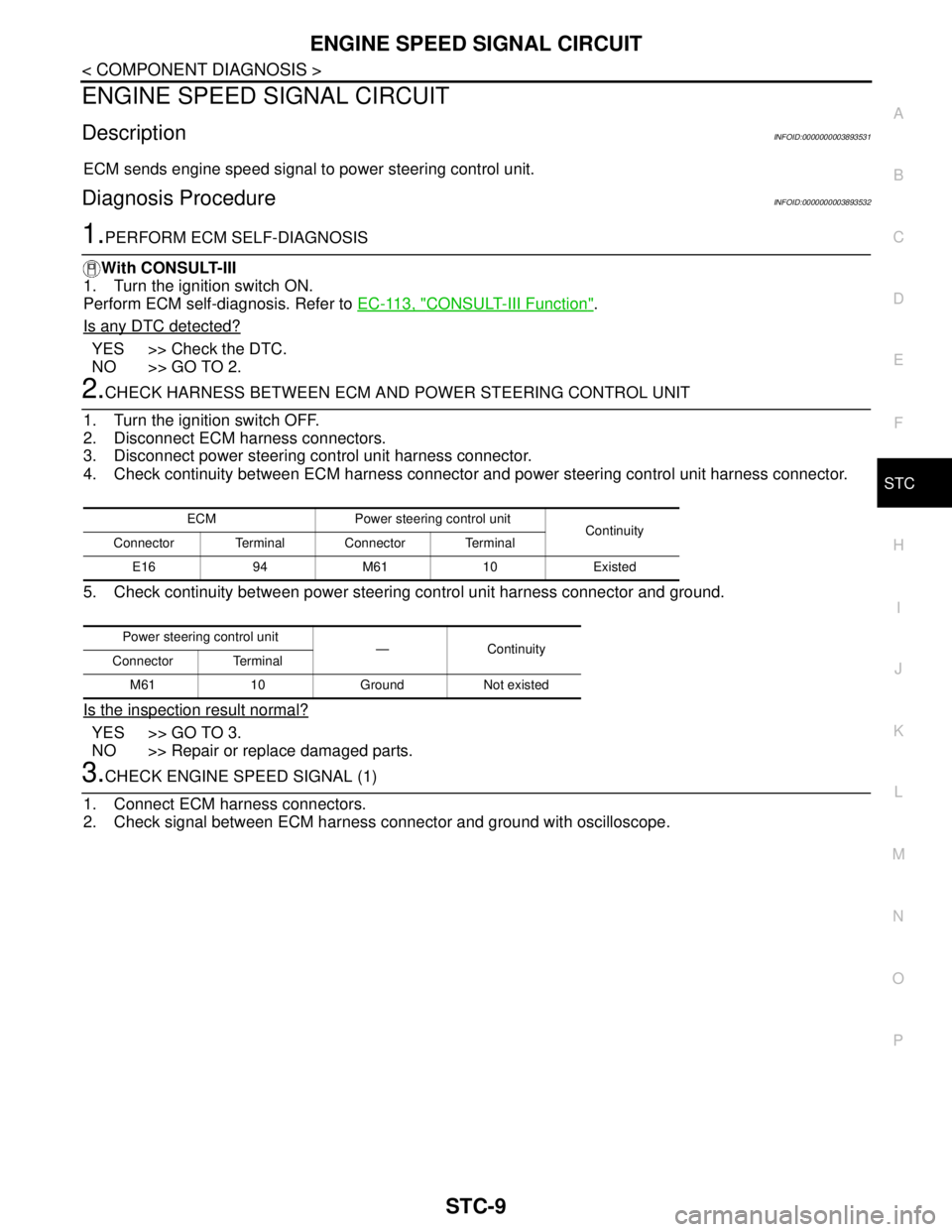
ENGINE SPEED SIGNAL CIRCUIT
STC-9
< COMPONENT DIAGNOSIS >
C
D
E
F
H
I
J
K
L
MA
B
STC
N
O
P
ENGINE SPEED SIGNAL CIRCUIT
DescriptionINFOID:0000000003893531
ECM sends engine speed signal to power steering control unit.
Diagnosis ProcedureINFOID:0000000003893532
1.PERFORM ECM SELF-DIAGNOSIS
With CONSULT-III
1. Turn the ignition switch ON.
Perform ECM self-diagnosis. Refer to EC-113, "
CONSULT-III Function".
Is any DTC detected?
YES >> Check the DTC.
NO >> GO TO 2.
2.CHECK HARNESS BETWEEN ECM AND POWER STEERING CONTROL UNIT
1. Turn the ignition switch OFF.
2. Disconnect ECM harness connectors.
3. Disconnect power steering control unit harness connector.
4. Check continuity between ECM harness connector and power steering control unit harness connector.
5. Check continuity between power steering control unit harness connector and ground.
Is the inspection result normal?
YES >> GO TO 3.
NO >> Repair or replace damaged parts.
3.CHECK ENGINE SPEED SIGNAL (1)
1. Connect ECM harness connectors.
2. Check signal between ECM harness connector and ground with oscilloscope.
ECM Power steering control unit
Continuity
Connector Terminal Connector Terminal
E16 94 M61 10 Existed
Power steering control unit
— Continuity
Connector Terminal
M61 10 Ground Not existed